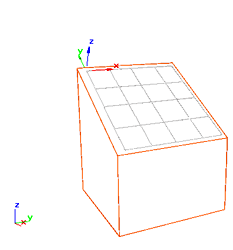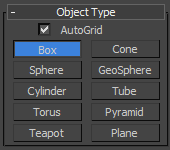![]()


AutoGrid used to position the second block on top of the first
When you use AutoGrid, this feature generates and activates a temporary construction plane based on the normal of the face that you initially click. This method is an alternative to creating objects first and then aligning them later.
You can use objects within an XRef scene as reference when AutoGrid is on.
Procedures
Example: To create a box aligned to another object using a temporary construction grid:
- Create or load a scene containing an object to which you want to align a new box.
- On the
 Create panel
Create panel  with
with  (Geometry) active
(Geometry) active  Standard Primitives
Standard Primitives  Object Type rollout, click Box.
Object Type rollout, click Box. - Turn on AutoGrid.
- Merge the object you want aligned.
- Move your cursor over the object to which you want to orient the box you are about to create.
The cursor includes an X,Y,Z tripod to help you orient the position of the new object. As you move over the object, the cursor aligns the Z axis to the surface normal.
- When the orientation is as you want it, click and use the standard drag-release-move-click method to create the box. The box will be created on the designated surface.
When you click, a temporary, automatic grid is created, and the newly created object is aligned to that grid.
Interface

Object Type rollout
- AutoGrid
-
AutoGrid is available only after you select an object button (such as Box). When you turn AutoGrid on, the cursor includes an axis tripod to help you orient the grid. Before clicking and as you position the cursor over a visible mesh object, the cursor jumps to the nearest point on that surface. The tripod's X and Y axes form a plane tangent to the object surface (forming an implied construction grid), and the Z axis is perpendicular to the plane.
After creating the object, 3ds Max places it on the temporary construction grid. When creating an object, if the cursor isn't over another object, 3ds Max places the object on the current active grid.
Tip: When you create an object that requires multiple clicks, AutoGrid applies only to the first click. So, for instance, if you want to create a Line spline that snaps to the faces of a sphere, turn on Snaps (press the S key), and then open the Snap Settings and turn on Face.Note: To make the grid permanent, hold down the key before you click. The grid becomes active and 3ds Max turns AutoGrid off.
key before you click. The grid becomes active and 3ds Max turns AutoGrid off.